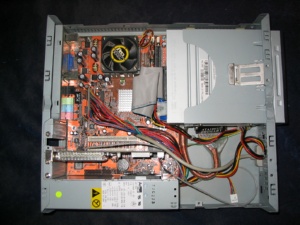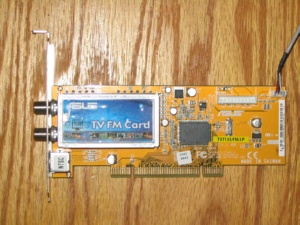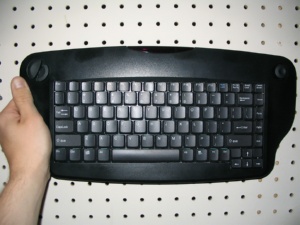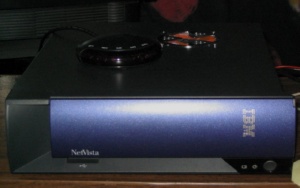Introduction
After a friend of mine got a TiVo for Christmas I was instantly addicted to the PVR phenomenon. Anyway, to make a long story short, I ended up with an extra computer after I bought a better machine for my carputer. Now with an extra small from factor machine, I could turn it into a custom multimedia center for my roommates and I. The following is my experience with MythTV and I hope it can aid you in building one of your own.
Parts
The machine is a micro-ATX Syntax motherboard with an integrated AMD Duron 1.3 GHz, 256 MB of DDR, a spare 20 GB hard drive I had lying around, a CD-RW drive, and an ASUS TV FM card. I squeezed it all into an IBM Netvista case I bought off eBay for about $20. It's a nice case, about the size of a TiVo, and even comes with a power supply but it's not made for just any micro-ATX motherboard. I had to pull out my Dremel tool to make the I/O shield fit and tape over a couple of spacers so it wouldn't short out the board. It also gets way to hot for the powerful hardware that I squeezed in such a small case so a fan hole had to be cut in the top. The 1.3 GHz Duron seems to be fast enough to encode one show while watching another without problems.

I originally started with an ATI TV Wonder card featuring a bt878a chipset. It's an older card with average picture quality and mono sound but the bt series chipsets are very well supported and already included in the 2.4 and 2.6 kernel trees. I decided to step it up a notch and went with an ASUS TV FM card. They can be had for about $35-40 and feature the Phillips saa7133 chipset. It has a much sharper picture and stereo sound but you'll have to do some kernel patching and recompiling to get it working. Update: Support for this card is now standard in the 2.6 kernel. Another option would be to go with a card featuring the conexant 2388x series chips, such as the ATI TV Wonder Pro. They also should have a sharp picture and stereo sound, however the driver for these cards is still very new and undeveloped. MythTV doesn't require a TV tuner with hardware based MPEG compression, such as the Hauppauge PVR350, but it does support them with a little work. These types of cards will take a lot of strain off of your CPU allowing you to use a much cheaper, less powerful machine. They can also serve a superior image compared to the software encoders.

I decided to control it all with a cheap infrared, WebTV sized, keyboard. MythTV supports remote controls using LIRC but it doesn't allow me to go quickly from watching TV to hacking the box like a keyboard does. I may buy a TiVo remote from eBay and allow control from that as well in the near future.

Software
I decided to go the quick easy way and install KnoppixMyth R4V2. All you need to do is burn the .iso, boot it, and hit a few keys. It will format and partition your hard drive then install all the files it needs for a fully functional MythTV system. It worked great with the bt878a tuner card but I couldn't get it to function with the saa7133 card due to some library weirdness (possibly my fault). I decided to restart fresh and went with Mandrake 10 and a cvs version of MythTV (pre v0.15). I went with a small as possible install making sure I got MySQL, Samba, Apache web server, PHP with the MySQL module, all the Perl modules, all of the qt packages, the OpenSSH server, and X windows with IceWM. You could use any window manager you like, but I wanted something small and light, and IceWM is perfect for that.
Installing MythTV was easy following the HOWTO on MythTV's web page. To have MythTV start automatically on bootup I used Mandrake's configuration tools to auto logon a MythTV user. Next create a .IceWM folder in the MythTV user's directory.
Update: MythTV 0.15 was just released along with KnoppixMyth R4V4 and it includes the latest V4L drivers so it might be worth looking into for any TV card now.
